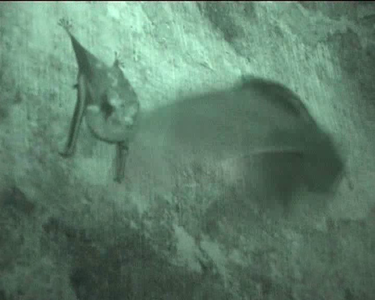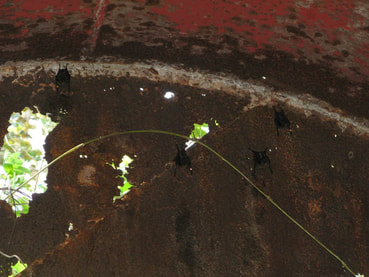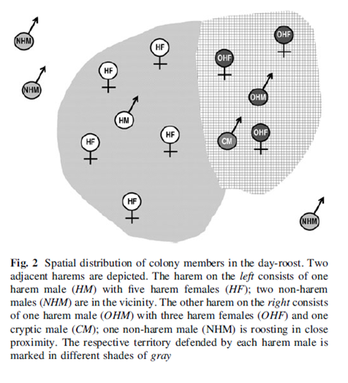What is a greater sac-winged bat?
Saccopteryx bilineata, the greater sac-winged bat, is a small, fairly common emballonurid native to Central and South America. Known for being the first non-primate example of babbling behavior as a precursor to organized adult vocalization (Knoernschild et al. 2006), these bats are highly social and spend a large portion of their time interacting in the "day-roost," using acoustic, olfactory, and visual communication. The males have pouches, or sacs, on their wings, which can be filled with urine and other glandular secretions, creating a pungent cocktail which is blasted at females during courtship displays. (Voigt and Von Helversen, 1999).
Social Spacing for Harem Maintenance
|
Saccopteryx bilineata groups are structured around a polygynous mating system, which represents an excellent model for social spacing analysis. The choice of individual roost-sites within a day-roost constitutes an enduring, often repeated decision about relative proximity to conspecifics. Day-roost colonies consist of one or multiple harem groups, each with several females and a single male. Additionally, non-harem males without females may be present.
Harem males and females spend the most time in close physical proximity, with harem males located at the center of harems instead of at the borders. Non-harem males associate significantly more closely with one another than with harem females (the theoretical objects of their desire). Our results suggest a concentric social organization based around harem males, which may select roost sites in closest possible proximity to females to enhance courtship signal strength. This constitutes an interesting deviation from the normative form of harem maintenance, patrolling borders, in mammals, and may be derived from the female-biased size dimorphism in this species. In this case it may be that harem males use multimodal signals to monopolize females through attraction rather than mate-guarding and harem-herding (Fulmer and Knoernschild, 2011). |
Endurance in Courtship Displays

Though harem and nonharem males exhibit the multimodal "hover" display with roughly equal frequency, harem males maintain displays significantly longer than nonharem males. Nonharem male displays did not vary with age, but harem male displays increased in duration with age (Knornschild et al., 2010).
Research supervised by Dr. M. Knoernschild.
Image from video property of M. Knoernschild.
Research supervised by Dr. M. Knoernschild.
Image from video property of M. Knoernschild.

